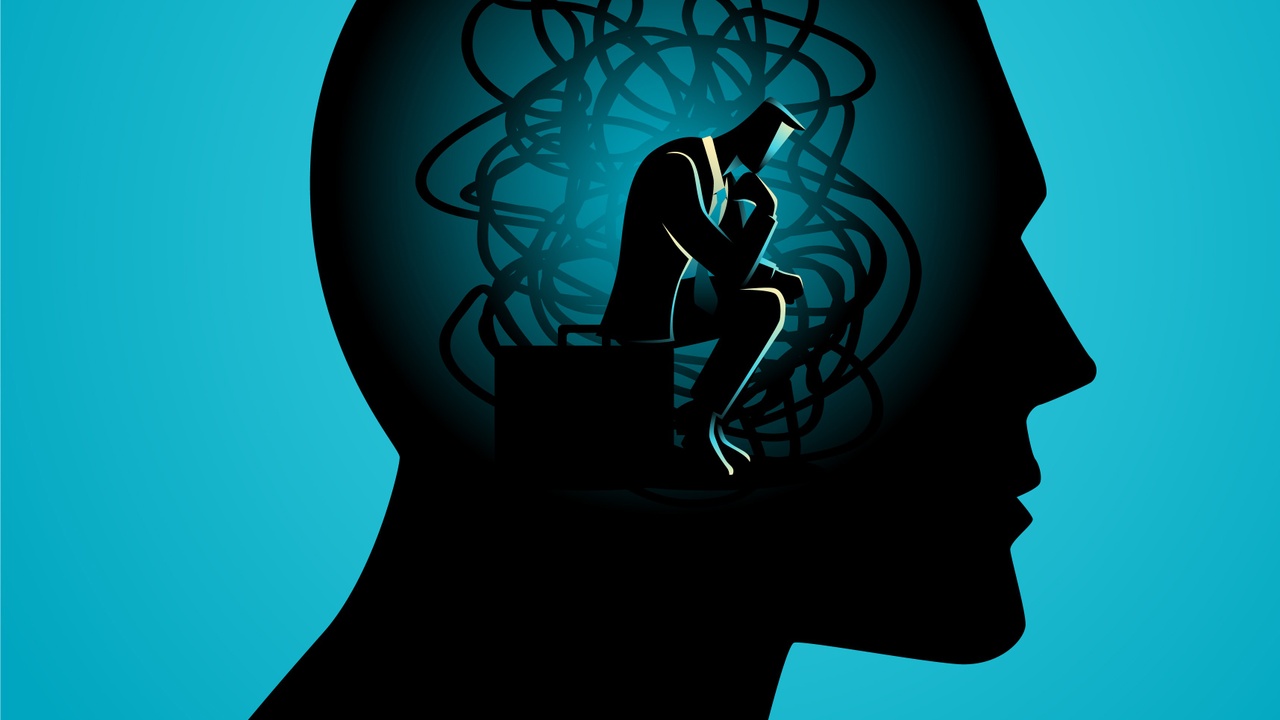What is Anxiety
Jun 05, 2022
General Anxiety
Anxiety, for the most part is a natural response to a scary feeling or sense of danger. When presented with an unknown possible threat, or situation which makes you feel uncertain, there is a part of our brain which decides whether we must stand and fight, run away or stay still in hope the threat will go away. You might know this as the fight, flight or freeze response (Claringbull, 2011).
The science behind Anxiety
Historically, humans have survived based on the presence of a part of the brain, called the amygdala, a small, almond shaped structure found in the limbic system. Also referred to as the Chimp part of the brain, it is responsible for quick reactions to potentially heightened emotional experiences (there are actually 2, one on either side of the brain). This development of the brain, taught our ancestors in cave times how to react to predators. We therefore, evolved because we learned how to survive a potential threat or danger (The Brain From Top To Bottom,2020).

In these modern times, it is hard to understand why our brain still reacts in this way, when the dangers we once faced are no longer a part of our everyday lives (unless you live in the jungle). However, it does still serve a purpose to us today.
For example, where would we be without the fear response of our brains, when faced with crossing a road or standing close to a fire? We would be run over on the road because we have not learned to be fearful of fast-moving cars and we would be burned by the fire because we would not be fearful of the flames.
The amygdala is also responsible for how we process feelings, how we perceive other people’s comments made towards us and how we respond to an emotion expressed to us. It subconsciously tells us to be wary of strangers and to be on guard when in new environments, a sort of gut instinct kicks in. This response can present very quickly, especially when a situation is perceived as out of the norm or something which feels out of our control. For instance, arguing with a child to the point you shout at them, it is not because you are angry at the child for not listening, it is the chimp part of the brain telling the rest of the brain, that it is not handling the situation effectively and therefore, feels it should step in to eradicate the threat (fight, flight or freeze).Therefore, It is not your fault you responded this way, the chimp is a subconscious part of the brain, you can however, through awareness of your reactions to certain situations, learn how to quieten this response down and react in a more rational way. The amygdala is a crucial part of the brain functioning, without it we, as a species would not be here today.
FACT * People who have suffered a stroke which has resulted in damaging the amygdala, can lose part or all of their emotional regulatory system, changing their personality, the way they talk and respond to others and at times the ability to be understanding, or to know the difference between what is right and wrong, amongst many other changes.
So, you see the amygdala is an essential part of the brain, proving that fearful responses as well as painful ones, as much as we may want to be rid of them, are still a requirement in today’s society, without it we would not have our humanity. In his book the chimp paradox, professor Steve Peters, explains that the chimp part of the brain is the first responder to all experiences and at times can overpower the human/Logical thinking part of the brain (Pre-fontal cortex) when it feels threatened, resulting in anxious responses taking over. We must therefore learn how to calm the chimp, to enable a more rational way of thinking and reacting. When we recognize unnecessary or unwanted threats and are able to reflect and re-process our reactions, we are able to rebuild our thinking and foundations based on a more self- aware and self-controlled response system.
You can find a more detailed explanation into the Chimp Paradox by following the link found in references, to Professor Steve Peters, writer of The Chimp paradox.
 How to recognise Anxiety
How to recognise Anxiety
We have learned how the Chimp part of the brain is responsible for how we as humans, react in situations which it can perceive as threatening. With this understanding we can now look at the physical feelings of anxiety.
Symptoms of anxiety are sometimes very subtle, we may not even recognize them as anxious responses however, if left un-noticed these subtle triggers can escalate into something more. It is therefore important, to learn to recognize how your body reacts to what your mind (chimp) is portraying. Below is a general, hypothetical situation we may come across in our everyday lives.
- shows an irrational response to the situation (when you are not in control of your reactions).
- highlights some of the possible physical reactions, which co-inside with the psychological, irrational response.
- provides a more rational response (when you are in control of your reactions).
Situation:
At work, you notice little conversations happening around you, it seems like people are looking at you and giggling.
1.Irrational Response:
Everyone hates me, they are all laughing at me, I am ugly, I am not good enough, I just wish I were normal, like everyone else. Maybe it would be better if I quit.
2.Physical Responses:
Clammy hands.
Heart palpitations.
Breaths become shorter.
Sick feeling in stomach/ digestive issues.
Teary eyed.
Mouth becomes dry.
3.Rational Response:
I have really noticed people are looking at me when they are giggling in the office today. Perhaps they are planning something for my birthday next week, if not and they are being mean, I hope that they are ok.
You see, when people do treat others in a mean way, it is usually because something is missing or making them sad in their own lives, taking it out on others, deflects their feelings to an external source instead of addressing what is going on for them internally. Typically, this is also a response in that person’s brain which could be linked to their own chimp’s irrational behavior. Perhaps the next time you witness this behavior, you could ask the person if they are feeling ok themselves, they will either be mean (fight) walk away (flight) or be stunned to silence (freeze). Ideally, freezing to reflect, could possibly lead to the person eventually opening up about how they feel. This hypothetical example shows that you are not alone in your feelings and responses to situations.

What happens if Anxiety takes over
When thoughts become overpowering, they can manifest into both physical feelings as mentioned above (3) and psychological symptoms which can include paranoia, loss of concentration, sleeping difficulties or feeling low and irritable or fear of people and places. Experiencing a few or all of these symptoms whether psychological, physical or both if not acknowledged, can lead to suffering what is known as anxiety disorder, if left untreated can lead to depression and in the long term can be harder to recover from. However, most of the time we recognize an imbalance and can learn to create a more rational response system by having an awareness of what tools and techniques can help.

What can help reduce general anxiety
If you suffer with anxiety it can help to learn some useful techniques to use for when you recognize an anxious response looming or find yourself in full anxiety mode. Techniques can also teach us to reflect on and reduce the irrational thoughts as they come up.
I have complied a small list of useful tools below, which have helped me and my clients in the past. Finding a hobby, a new interest or rekindling a passion, can really help with anxiety. The list is non-exhaustive and I encourage you to try different ways of learning which techniques and tools are right for you and your anxiety. I also recommend that if you think anxiety affects you in way you feel unable to cope with alone, it is important you seek help from someone you trust, a doctor, psychologist or counsellor/psychotherapist, specializing in anxiety and depression.
Toolbox
Mindfulness Techniques – reading, coloring, puzzles, Lego/brick building, art and crafts, painting, drawing, listening to relaxing music, meditation, Yoga/Pilates, gardening, dancing, singing, going to the gym, running, swimming, walking or learning a new skill you’ve always wanted to try.
Note: You do not need to be the perfect artist to enjoy creative hobbies, you just need passion and the want to try. When a want turns into a need it becomes a must!
When an anxiety attack is too close, for mindfulness alone
When a reaction comes out of no-where and we are unable to recognize the warning signs, perhaps you have woken up to a full-on anxiety attack, you cannot expect that pulling out a guitar to play a nice song will help. You are in survival mode. When in this survival state, the brain is shutting down non-essential functioning, tingling sensations in the hands can be felt because all the oxygen in the body is being redirected to the organs to survive and to the feet, ready to run if necessary. Your mouth is drying up because the brain has no reason to create saliva, (when in survival mode the furthest thing from your mind will be food or water). Vision can become blurry because of the lack of oxygen and your heart will be beating faster trying to pump as much oxygenated blood around the body as possible. As I write this, I can feel my own body responding to the thoughts as I write them, almost readying itself to react, my amygdala remembers what anxiety feels like and has connected my past memories and anxious thoughts to use as a reminder, telling my body to react.
So, how do I stop it? I just took 3 deep breaths counting in for 7 and out for 7, already I feel my heartrate decreasing as I gain back control of the emergency my brain though it was in. Counting to 7 is comfortable for me, you might like to begin with in for 4 and out for 4, this technique can be harder to do the more anxious you feel.
If I were reacting in an extreme state, I would be thinking of the 5 senses response technique, to help me ground myself.
5 Things you can see – concentrating on sight encourages the brain to re-direct oxygen back to the eyes, increasing sight to normal functioning.
4 Things you can hear – listening to external noises, helps to distract from internal thoughts.
3 Things you can touch – touching different surfaces, encourages blood to be restored to the fingers
2 Things you can smell - engaging your sense of smell, tells the brain it is more concerned trying to smell something than on the threat it is perceiving.
1 Thing you can taste – carrying a small sucking sweet or chewing gum and putting it in your mouth during an anxiety attack encourages the saliva gland to re-engage, as mentioned above, the first reaction to danger is that the saliva gland stops working, by re-engaging this sense, you are sending a message to the amygdala that there is no current danger, you are proving this by creating the need to produce saliva.
This technique is the most popular recommended to anxiety sufferers, another tool can be reflective journaling. This doesn’t need to be a long task, it is performed after the event or thought has occurred and once you are in a more stable and rational state, to establish the trigger and help to process how you may have better responded. If you’d like to know more on this, try researching on the internet: reflect writing for anxiety.
Reflecting on triggers can help you to identify where, when and why an anxious thought or feeling presented itself to you. It may be that being around certain people or in particular places trigger emotional and irrational responses for you. Having this awareness can help you to identifying which methods or techniques can help you to change these responses.
Author: Rebecca Hay
RH Counselling Service Colchester, originally published April 2020, republished June 2022
References
Claringbull, N. 2011. Mental health in Counselling and Psychotherapy. 1st ed. Exeter: Learning Matters Ltd, pp. 78-87
Peters, S. 2012. The Chimp Paradox: The acclaimed Mind Management Programme to Help you achieve Success, Confidence and Happiness. 1st ed. London: Penguin books Ltd
Mind.org.uk. 2020. Panic Attacks. [online] available at: https://www.mind.org.uk/information-support/types-of-mental-health-problems/anxiety-and-panic-attacks/[Accessed 20 April 2020].
Thebrain.Mcgill.ca.2020. THE BRAIN FROM TOP TO BOTTOM. [online] Available at https://thebrain.mcgill.ca/flash/d/d_04/d_04_cr/d_04_cr_peu/d_04_cr_peu.html[Accessed 18 April 2020].

